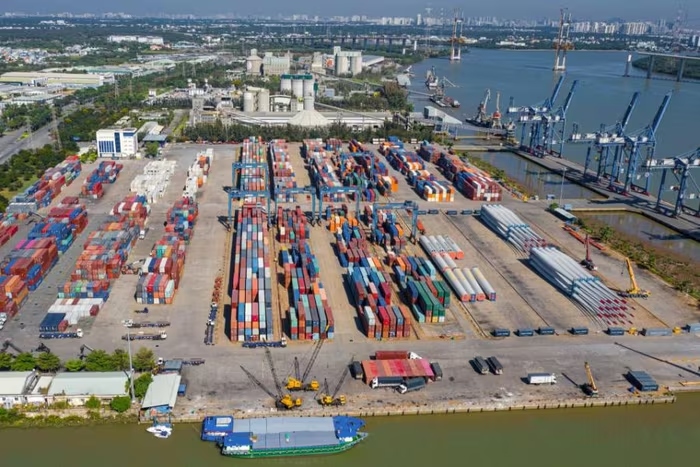Seaport advantages increase the attractiveness of industrial real estate
Posted on: 10/09/2025

Illustration photo.
Savills Global Occupier Insight - Industrial Focus 2025 report assessed that Vietnam possesses a strategic geographical location and a long coastline, creating a solid foundation for the development of a widespread and potential seaport network.
This seaport system is not only a pillar to promote exports, but also an important link to connect international trade, helping to improve the competitiveness of Vietnamese goods in the global market.
CONNECTED WITH MANY MAJOR EXPORT REGIONS
Notably, in the Northern region, Lach Huyen deep-water port plays an important role as a commercial gateway for industrial provinces in the Northern Key Economic Zone. In the South, Cat Lai and Cai Mep – Thi Vai ports operate as key logistics centers, connecting Binh Duong , Dong Nai, and Ba Ria – Vung Tau (old) with international shipping routes.
According to the Vietnam Seaports Association, in 2024, the seaport system nationwide handled about 22 million TEUs and is expected to continue to grow. Not only that, recently, Vietnam has made significant progress in synchronizing seaport expansion with the development of logistics infrastructure and supporting industries. Thanks to that, deep-water ports such as Cai Mep - Thi Vai are now surrounded by a complete logistics system, including: logistics parks, bonded warehouses, and modern cold storage that meet international standards.
To further boost the industry, in early 2025, the Prime Minister approved the investment policy for the Can Gio international transit port project with a total minimum capital of VND50,000 billion (USD1.96 billion). In parallel, the Lien Chieu deep-water port, expected to be completed in 2025, will also become an important infrastructure for transporting goods from Da Nang out of the Central Highlands, Laos and Northeastern Thailand, allowing multimodal connections to the logistics corridor.
However, Mr. Thomas Rooney, Deputy Director of Industrial Real Estate Services , Savills Hanoi, said that the progress of infrastructure development is uneven. In some provinces, although there is abundant and affordable industrial land, the quality and availability of logistics infrastructure is still limited. The main challenges are the shortage of high-quality warehouse space, modest cold storage capacity, and lack of multimodal connectivity. In addition, the last-mile connection between seaports and production centers still requires large investments, especially in the Central and Central Highlands regions.
CUSTOMERS PREFER AREAS NEAR THE PORT
In fact, as global manufacturers shift their operations, many businesses have adjusted their location strategies, prioritizing areas near deep-water ports and logistics corridors. This trend is clearly evident in Vietnam.
For example, in the South, Ba Ria – Vung Tau (old) is a prominent locality in attracting large-scale tenants, thanks to its advantage of direct access to Cai Mep port and international shipping routes. Meanwhile, in the North, Hai Phong and its surrounding areas are increasingly popular due to upgraded seaport infrastructure and constantly improving customs clearance efficiency. In addition, emerging industrial clusters such as Quang Ninh, Thanh Hoa or Da Nang are gradually asserting their position, not only thanks to competitive costs but also thanks to increasingly expanding logistics services. These localities are highly appreciated by investors for their ability to connect to seaports and cross-border corridors.
Mr. Rooney said the shift in tenant priorities reflects a larger trend: industrial development in Vietnam is no longer solely based on land, but is shifting to focus on logistics readiness and trade facilitation.
Notably, the administrative reorganization, when some localities were merged, industrial centers that were previously located deep inland now have direct access to maritime trade infrastructure. These changes not only improve management efficiency, but also bring clear benefits to manufacturers and investors: shorter supply chains, reduced transportation costs and more streamlined export processes…
However, Savills also emphasized that Vietnam’s industrial and logistics transformation is not happening in isolation, but is linked to global changes in trade, production and consumption. As companies prioritize supply chain resilience, geopolitical neutrality and proximity to fast-growing consumer markets, Vietnam is ideally positioned to benefit.
However, this opportunity does not come naturally. To take advantage of this opportunity, Vietnam needs to ensure that its seaport system not only operates efficiently, but is also closely connected in a synchronous logistics ecosystem. At the same time, industrial parks must be fully equipped with services, connecting infrastructure and ready to become strategic destinations for international manufacturers in the future.